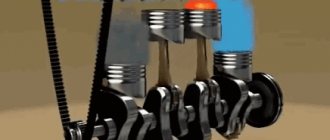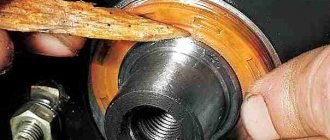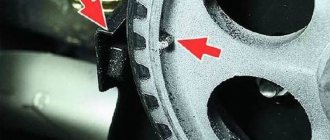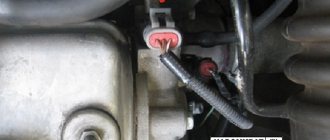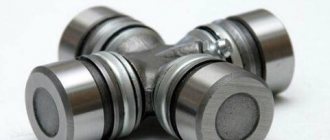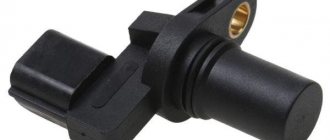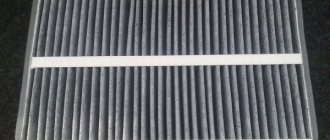The camshaft (camshaft) is the most important element of the gas distribution mechanism. In fact, with the help of cams, the shaft pushes the valves, allowing the timing belt to work smoothly and accurately; the opening and closing of the intake valves occurs at a precisely defined moment.
Like any other mechanism, the timing belt also wears out. As a result, malfunctions and knocking appear. In this case, engine knocking is often associated specifically with the camshaft, and not with the crankshaft and crankshaft as a whole.
If the camshaft is knocking, in such a situation you can do the following:
- camshaft repair;
- replacing the camshaft.
It is important to know how to remove the camshaft for repair or replacement. It is also necessary to understand how to change the camshaft on a car, how the camshaft is tightened, etc. Read more in our article.
Indications for replacing the camshaft
The condition of the camshaft must be monitored regularly and carefully.
Its malfunction can also cause large-scale damage to the engine of a Japanese car itself. Usually the camshaft begins to “mope” with a dull knock when the engine starts. On cold engines, noise can be heard in the valve cover area. Experienced drivers understand the inner voice of their car, quickly identify the rumbling of the engine and “left”, uncharacteristic noises. They are able to immediately distinguish the quiet and even sound of the camshaft, which changes frequency depending on the engine speed. If a part is faulty, this is accompanied by dull tapping sounds reminiscent of hammer blows.
The malfunction is also indicated by:
- deterioration in the smooth running of the machine;
- drop in engine power;
- unstable operation at idle speed;
- strong vibration of the motor;
- Difficult to start in cold weather.
Particular attention is paid to the camshaft seals - they should not have ruptures, cracks or abrasions. The integrity of the drive must also be inspected.
However, it is difficult to determine camshaft wear by indirect signs. It is much easier to do this on a removed part, inspecting it visually from all sides. There should be no potholes, scuffs, or aluminum leaks from the bearings anywhere. A sign of undoubted wear is grooves and irregularities on the surfaces of the rocker arms and cams.
Checking camshaft wear
When dismantled, the camshaft can also be listened to. To do this, you need to hold it parallel to the ground with one hand, and tap on top with the other. There should be no knocking. A mandatory condition: the camshaft should not “walk” on the bed! Otherwise, clinging to the limiter, it will inevitably create noise, which can be mistaken for a malfunction.
High-quality camshafts are rarely damaged prematurely. But Chinese products or those repackaged in this country have a hardness 1.5 times lower than that of the original ones. A good shaft is made from forged steel.
Camshaft position sensor
The camshaft sensor detects the current position of the camshaft. Depending on the readings of the crankshaft sensor and camshaft sensor, the engine control unit decides how to inject fuel and how to control the detonation of the power unit.
Camshaft sensors fail quite often. As a rule, if the sensor malfunctions, the engine idle speed begins to fluctuate. Also, a “Check Engine” icon appears on the car’s dashboard, and an error code for the engine control unit is recorded in the computer’s memory, which can be used during diagnostics to decipher the reason for the appearance of the “Check Engine” indication.
Replacing the camshaft sensor is relatively simple. Usually you don't even need to remove the engine valve cover to do this. But everything, of course, depends on the engine design, make and model. On average, it takes from 30 minutes to 2 hours to replace a camshaft sensor. The sensor itself costs approximately from 2000 to 6000 rubles. But the cost certainly depends on the car. You understand that a camshaft sensor on premium cars can cost a hefty sum.
Replacing with a new or restoring the old camshaft
Damage is always analyzed. Based on scratches and burrs on the bearing journals, cracks and deformations, experts determine the degree of wear. The area where the node sits in bed must be examined. The dimensions of the necks and body supports are measured using a micrometer. If the damage is severe and the deviations in diameters are large, it is not advisable to carry out repairs. In this case, it will be difficult to restore the part, it will cost much more.
When the defects are minor - for example, the wear of the shaft is weakly expressed, scratches on the surface under the seals are small, repairs are carried out. In this case, grinding the surfaces and installing new oil seals with a small axial cross-section will help greatly.
One of the most common problems with camshafts is worn camshafts. This defect usually manifests itself with a characteristic knocking sound inside the engine when starting “cold”. If you ignore the initial symptoms, the problem will get worse. The noise will increase, a metallic clang will appear not only at the start-up stage, but also during the movement.
Camshaft cam
The causes of early cam wear are:
- oil filter clogged;
- refueling with low-quality auto scrap;
- frequent overheating of the power plant - the metal of the cams begins to “lead” from this;
- low lubrication level;
- incorrectly set valve clearance;
- Incorrectly set phases of the gas distribution system.
The second common malfunction is defects in the support journals. These include nicks, scratches, and various abrasions. Supporting elements also bend, crack, and change their original shape. Minor types of violations are caused by natural wear or poor-quality composition of the engine oil. They can be easily eliminated by grinding and simultaneously cleaning the internal parts of a car engine - cylinders, pistons, rings. At the same time, the oil pump and the internal combustion engine cooling system are thoroughly diagnosed, and their incorrect operation is corrected.
The curvature of the support journals is determined not visually, but using special equipment. There is an acceptable degree of curvature, which is determined by 0.05 mm (for passenger cars).
Significant defects cannot be ground, so the camshaft is replaced with a new one
However, it is extremely important to be able to identify the cause that led to the wear. Otherwise, the problem will repeat
As a rule, cams and bearings often break and wear out prematurely under extreme conditions. When a car is used more than normal, it gets into accidents and various collisions.
Skoda Superb 1.8T › Logbook › Final repair of the cylinder head (+ restoration of the camshaft beds)
The problem was described in an earlier post. Thanks everyone for the advice! Indeed, it turned out that the oil seals on the Erling intake valves were either fake or simply of poor quality. Carbon deposits formed on the intake valves, which prevented them from closing. And also, I think that this was the reason for my slight oil burn, which, as I initially assumed, was due to VKH. Now to the point. It was decided to replace the valves, unscrew the bushings, since some of the valves were slightly wedged in them, loosen the seats, and grind them in. The reamer was bought in a store at 7mm, if I’m not mistaken, but with cutters it’s more difficult. We found where to buy a set for a VAZ 2110. The angle of one of the cutters there corresponds to the angle of my cylinder head, but the pin is already 1mm smaller in diameter. We had to look for the axers that this pin made for us.
Next comes the processing of the saddles themselves. First, let's talk. Somehow some of the saddles themselves turned out imperfectly, so they found someone who helped and suggested. In general, we coped with the task.
We grind long and hard.
We collect everything and start it up. Works fine. We try to give gas, something happens in the engine, a loud knock appears. Disassemble again... We remove the cover and see that the hydraulic compensator has jumped out, got under the camshaft, and that in turn melted the camshaft bed... The picture is terrible. It is not clear why the rocker jumped out like that, or the pump simply didn’t pump enough oil, and the camshaft itself first scratched the bed. The fact is that the head and valve cover are damaged. It's not cheap. I wanted to have the head restored at Mechanics, but they refused because nothing would work well anyway. I found another one that took my cylinder head to work. The camshaft is slightly damaged, but not critically, there is no runout, so I decided to leave the old one (a new one costs at least 30 thousand). Here is what has deteriorated on the shaft:
I would like to express my gratitude to the employees of MotorIntech LLC for their quality work, in particular to the Inspector Yuri for his respectful attitude towards clients. Within a week they completed all the work to restore the beds, as promised. All this cost me 13 thousand, and a working used cylinder head costs about 50 thousand.
The need to replace oil seals
The camshaft oil seal (cuff) is a sealing ring that prevents oil from leaking out of the camshaft. This gasket is equipped with engines that are equipped with a gas distribution mechanism (timing belt). If it suddenly does not perform its tasks, then the seal needs to be changed.
The main reason for malfunction is normal mechanical wear. All seals are common consumables, and after a certain amount of time they begin to deteriorate because they are made of elastic materials.
Any defect may appear: swelling, change in shape, tears, scarring, etc. Another possible malfunction: the cuff can be squeezed out of its seat.
It happens that the cuff is defective or installed (selected) incorrectly. In such situations, it is also necessary to change the camshaft oil seal, because it does not fulfill its intended purpose.
Oil seal failure is diagnosed visually. If it leaks, you can see traces of oil on the timing belt cover. In order to more accurately determine the extent of the problem, you need to remove the belt cover and conduct an inspection. If there is a malfunction, traces of wear will be visible, or due to increased moisture, the belt has jumped over one or a couple of pulley teeth.
We recommend
“Replacing gearbox seals: subtleties and tricks” More details The fact that the seal is faulty can be seen when it’s time to change the timing belt according to the plan. It is then that oil leaks can be detected on the belt or on the camshaft gear. If the seal is deformed, it should be replaced, despite the fact that oil is not leaking at this moment. However, changing the shape of the oil seal will cause oil traces to appear.
In addition to the above, the element should also be replaced if obvious mechanical damage is detected. This procedure is not urgent, and the car can be operated carefully for a long time. However, you should still know how to change the camshaft seal if it unexpectedly fails.
Moreover, if there are significant oil losses due to a damaged seal or the element is severely damaged, then there is no escape from replacement.
After traveling a certain number of kilometers, the car develops oil traces in the area of the camshaft pulley and oil seal. As the mileage increases, so do the leaks. This situation indicates that it is time to change the camshaft seal.
The problem here is not the loss of oil, but the fact that it is transferred to the timing belt and camshaft drive pulley. This turn of events becomes dangerous because the hot oil causes the rubber of the belt to deform. In this case, the oily liquid makes the belt slippery, and it may begin to slip on the pulley teeth.
As a result, cracks may form on the pistons or bend the valves. Be that as it may, you should change the seal to get rid of oil traces.
Device and principle of operation
The camshaft is a rod with cams and bearing journals. The number of cams corresponds to the number of valves.
The element is connected to the crankshaft using a timing belt or chain. The belt drive is quieter, costs less, but needs regular replacement (60-90 thousand km). Chain transmission is noisy, expensive, does not require frequent maintenance, and has a long service life.
The camshaft is driven by special plain bearings. By rotating, the element regulates the phases of the gas formation process in accordance with the engine operating cycle.
When acting on the valves, the camshaft has to overcome the resistance of the springs, which act as a return mechanism. And the entire working process takes place under conditions of high pressure and temperature. And, despite the fact that the spare part is made by casting iron or forging steel, replacing the camshaft will still be necessary sooner or later.
What affects the serviceability and operation of the DPRV
The main factors that affect the operation of the sensor are temperature changes, shaking and metal dust. Therefore, it is necessary to replace the sensor every 100 thousand kilometers. This will avoid unexpected breakdown. When the engine is turned on, the temperature in the sensor area corresponds to the air temperature. As the motor heats up, the temperature of the sensor also increases. If the power supply or ignition systems are not adjusted, the engine runs intermittently, and the sensor is affected by stronger vibrations than designed. The engine has a lot of rubbing metal parts, the movement of which leads to the appearance of dust. If the lubrication system is not working properly, or the engine mounts are faulty, then more metal dust appears than usual. Some of it settles on the magnetic surface of the sensor, negatively affecting its operation.
Timing gears
This is worth talking about separately. The gas distribution mechanism requires very precise gear adjustment. Often it is enough to align the gears according to the camshaft marks on the VAZ-2106. But for more precise adjustment there is a special split gear. The teeth in it are fixed with bolts to the base.
More expensive cars have modern engines where this process is automated. Instead of a camshaft gear (as on the VAZ-2106), hydraulically controlled clutches are used. The sensor knows the current shaft angle as well as the engine speed. In this way, the gas distribution phases are adjusted for different engine operating modes.
How to understand that the camshaft needs to be changed?
To determine if the camshaft is faulty without opening the hood, there are two signs:
- Knocking;
- Reduced engine oil pressure.
The main cause of camshaft failure is the appearance of gaps. They appear between the magazines and the bearings of the frame on which the camshaft rests. The slots are formed because the camshaft parts are worn out. The gaps cause the shaft to move along a vertical or horizontal axis. If the shaft play is 1 mm, it affects the operation of the engine. Reasons for breaks:
- Timely replacement of the camshaft;
- Don't change your oil on time;
- Using low-quality oil;
- The driver works at low speeds, so there is little time, and parts wear out faster.
The camshaft also needs to be replaced if the oil passages are clogged. Before replacing parts, check for play, damage, deformation, or shaft runout.
ENGINE
| Detail | Thread | Tightening torque, N.m (kgf.m) |
| Cylinder head bolt | M12x1.25, | See Engine section |
| Nut of the stud securing the intake and exhaust manifolds | M8 | 20,87–25,77 (2,13–2,63) |
| Tension roller nut | M10x1.25 | 33,23–41,16 (3,4–4,2) |
| Camshaft bearing housing stud nut | M8 | 18,38–22,64 (1,87–2,31) |
| Camshaft pulley bolt | M10x1.25 | 67,42–83,3 (6,88–8,5) |
| Accessory housing mounting screw | M6 | 6,66–8,23 (0,68–0,84) |
| Nuts of the studs securing the outlet pipe of the cooling jacket | M8 | 15,97–22,64 (1,63–2,31) |
| Main bearing cap bolt | M10x1.25 | 68,31–84,38 (6,97–8,61) |
| Oil sump bolt | M6 | 5,15–8,23 (0,52–0,84) |
| Connecting rod cap bolt nuts | M9x1 | 43,32–53,51 (4,42–5,46) |
| Flywheel bolt | M10x1.25 | 60,96–87,42 (6,22–8,92) |
| Coolant pump mounting bolt | M6 | 7,64–8,01 (0,78–0,82) |
| Crankshaft pulley bolt | M12x1.25 | 97,9–108,78 (9,9–11,1) |
| Coolant pump inlet pipe mounting bolt | M6 | 4,17–5,15 (0,425–0,525) |
| Muffler exhaust pipe fastening nut | M8 | 20,87–25,77 (2,13–2,63) |
| Nut securing the flange of the additional muffler | M8 | 15,97–22,64 (1,63–2,31) |
| Nut securing the clutch cable to the bracket | M12x1 | 14,7–19,6 (1,5–2,0) |
| Nut of a bolt of fastening of a forward support of the power unit | M10x1.25 | 41,65–51,45 (4,25–5,25) |
| Nut of the bolt securing the left power unit support | M10x1.25 | 41,65–51,45 (4,25–5,25) |
| Nut securing the left support bracket to the power unit | M10x1.25 | 31,85–51,45 (3,25–5,25) |
| Nut securing the rear support of the power unit | M10x1.25 | 27,44–34 (2,8–3,47) |
| Nut of the bolt securing the rear support bracket to the power unit | M12x1.25 | 60,7–98 (6,2–10) |
| Bolt securing the oil receiver to the main bearing cover | M6 | 8,33–10,29 (0,85–1,05) |
| Bolt securing the oil receiver to the pump | M6 | 6,86–8,23 (0,7–0,84) |
| Oil pump mounting bolt | M6 | 8,33–10,29 (0,85–1,05) |
| Oil pump housing bolt | M6 | 7,2–9,2 (0,735–0,94) |
| Oil pump pressure reducing valve plug | M16x1.5 | 45,5–73,5 (4,64–7,5) |
| Oil pressure warning light sensor | M14×1.5 | 24–27 (2,45–2,75) |
| Carburetor mounting nuts | M8 | 12,8–15,9 (1,3–1,6) |
| Cylinder head cover nut | M6 | 1,96–4,6 (0,2–0,47) |
How to set marks on a VAZ 2107 Injector
As for the VAZ 2107 carburetor engine, therefore, on the injection engine, the gas distribution mechanism in combination with the drive remained the same, in other words, the chain. If the chain is excessively worn, there are a number of negative consequences:
- Problem starting the engine.
- Significant increase in fuel consumption.
- The appearance of soot on valve seats.
- Abnormal engine operation in all modes.
- Faulty injection control sensor.
Timely preventive work is necessary to avoid such negative consequences. We will learn more about how to set time stamps on the VAZ 2107 Lada family with an injection power system.
Valve timing is when the piston in an engine moves up and down over a period of time. If the valves fail, the pistons move incorrectly for a certain period of time, and as a result, the engine on the VAZ-2107 runs unevenly.
If the driver notices that the car's power is decreasing, fuel consumption is increasing, and interruptions occur when the engine is running, then it is necessary to resort to setting the valve timing. We will learn from this material how to stick markings on the carburetor and injector of a VAZ 2107, since the design of the synchronization mechanism is similar.
The procedure includes the following manipulations:
- The VAZ 2107 must be installed on a hard surface, the wheels are blocked, and the handbrake is fully compressed. The gear shift lever must be set to neutral.
- The cover is removed from the cylinder head, having previously unscrewed our client, the fastening nuts remain at “10”. It is better to replace the gasket with the latest one, even if the old one shows no signs of damage.
- Use the “24” key to turn the crankshaft on the VAZ 2107. This allows you to align the marks on the moving and stationary parts of the mechanism. We recommend using low light or a flashlight to perform these steps. The crankshaft rotates without adjusting the torque quality until the mark on the pump and generator drive belt pulley matches the long-term risk inherent in the unit.
- Combining these dangers, the star rating should match the tide on the camshaft over time. If the mark is finally at the bottom, turn the crankshaft at full speed.
- If this doesn't work for label matching, proceed to the following steps:
- The crankshaft rotates until the marks connect with the sprocket and bed bosses.
- Using the “13” key, the tensioner must be loosened. 2.4 The tensioner nuts are unscrewed, then this device is removed.
- The screw is unscrewed, which secures the sprocket to the camshaft. To do this you will need to use the key at "17".
- The sprocket is removed, then it should be turned without performing high-quality torque adjustment until the marks on the VAZ-2107 timing belt pulley coincide with the long-term risk on the block. It is impossible to unscrew the sprocket mounting bolt because the camshaft sprocket rotates after removing the tensioner.
- The chain is put on the star if you decide to twist it and put it in place. Finally, the tensioner is installed, which must be tightened with 5 nuts to "10". You can install the tensioner first, but later you will need to use a breaker or mount to install the sprocket in this area. Finally, tighten the nut to “13”.
WEAK to set the time to zero? Camshaft, power chain and chain markings
This relative arrangement of the parts allows the piston of the 4th cylinder to be positioned at top dead center TDC.
If the VAZ-2107 is equipped with gas distribution markings, you must perform the following steps:
- The VAZ-2107 timing chain is tensioned.
- Adjusting the valves, or more precisely, the thermal gap between the camshaft cam and the rocker.
- Setting up a set of ignition accounting programs.
The process of adjusting valves on a VAZ-2107 is as follows: valves 6 and 8 are first adjusted, a report should be stored by the radiator. Once they are adjusted, you need to start adjusting 4 and 7 valves, then 1 and 3 valves, and then 2 and 5 valves at the end.
Thursday, June 9, 2016
How to set valve overlap in a classic VAZ engine
| Fan set of styli |
| Marks corresponding to the position of the crankshaft at TDC (carburetor) |
- 2. We replace the standard sprocket with a split one, fixing the bolts used to shift the phases on it.
Marks on the timing gear and camshaft housing - 3. Rotate the crankshaft 1 revolution and in this position, the cams do not put pressure on the rocker and set a gap of 1 mm between the rocker and the camshaft in the first cylinder!
- 4. Rotate the crankshaft again, aligning it with the mark; the mark on the camshaft sprocket will again be located near the tide on the RV housing.
- 5. We check the gaps on both valves of the 1st cylinder using feeler gauges of different thicknesses; for example, we get gaps of 0.1mm inlet and 0.3mm exhaust.
- 6. By minimally rotating the crankshaft a few degrees in both directions, we ensure that the gap on both valves becomes the same - 0.2 mm, this is the valve overlap point.
- 7. Loosen the screws on the split gear, now its outer part can be moved by rotating together with the crankshaft, while the camshaft will remain motionless. In this position, we set the crankshaft as accurately as possible according to the mark at TDC or, if necessary, shift it to set it ahead or behind. During these manipulations, the camshaft must remain motionless at the previously determined overlap moment.
- 8. After tightening the screws on the split gear, rotate the crankshaft 1 turn and adjust the valves, bringing the valve clearance to factory recommendations.
:
The problem with RV 21213 is that there are different heights of the intake and exhaust cams.
Don Alberto, this is not essential in order to find the camshaft angle at which both valves are open to the same height. For the classic PB 2101, which has a valve lift height in the ceiling of 0.8 mm, a gap greater than this value should be used, and the same for PB 21213.
It’s not clear, if at the valve overlap point they are open by the same amount, where does the gap between the cam and the rocker come from? The fist had already pressed on the rocker and opened the valve.
Roman Galiev, with a standard valve adjustment of 0.15mm, there is no gap in the overlap and the valves are open by 0.8mm, but if you adjust the valves to a gap of 1mm
, then a 0.2mm gap will appear in the overlap between the cam and the rocker, which I used to make the adjustment. Naturally, after adjusting the sprockets, the gap returns to the nominal value - 0.15 mm.
Thanks for the clarification, I didn’t realize it right away. It’s just that I have a 2.3mm overlap at the shaft and I can’t make the gap larger, the adjusting bolt is screwed in all the way. No way without indicators
